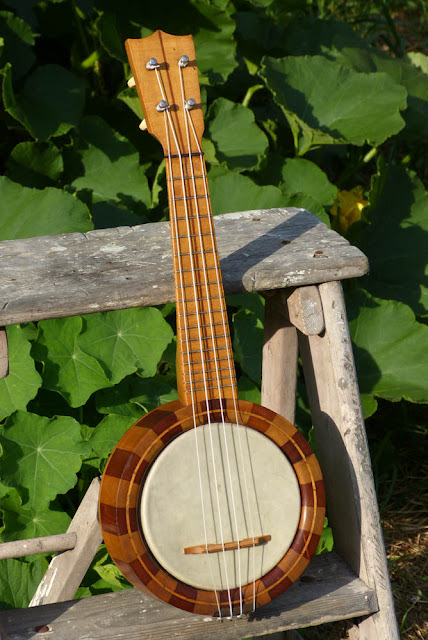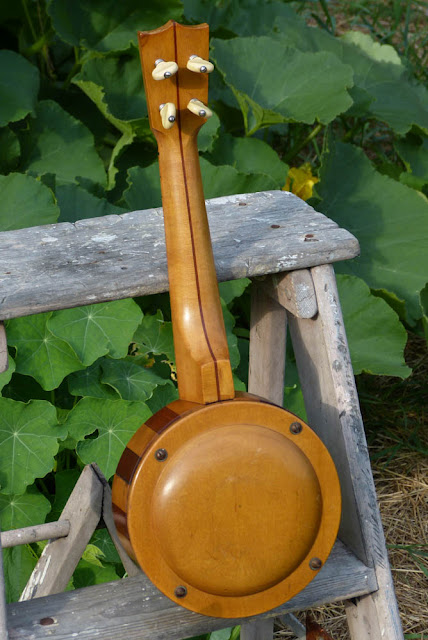1920s Oscar Schmidt Block-Rim Banjo Ukulele
I worked on the same model banjo uke back in 2013 and it was one of my favorite variations on the "California style" uke I've yet played. This one is, agreeably, much the same and also in excellent condition. I'm almost certain Oscar Schmidt made these in the 20s as the neck shape and headstock style, fret stock, scale length, and heel shape match up exactly with some Sovereign-branded OS banjo uke builds I've had in my hands.
At any rate, these ukes have "block rims" made up of contrasting pieces of maple and mahogany. The neck, too, is made up of two pieces of maple with a center stripe of mahogany. It's a flashy, folky look and extremely eye-catching. A friend of mine stopping by the shop saw this in the pile of "needing to get fixed" stuff and said, "did some hipster from New York drop that off?" Hah, no. But it is stylish.
Tonally these are in-between a plinkier-sounding "California" style banjo uke and a typical resonator-style banjo uke with a bit more clip. They've got a sort of horsey "clop clop" sound for chop chords that's really pretty endearing and I think the Nylgut strings bring out the best of it in terms of decent volume and fundamental sound.
Work included regluing one section of the block rim that'd been damaged, a fret level/dress, cleaning, new tuners (old 1920s friction peg install vs. original wood pegs) and a full setup. It plays perfectly and handles a lot like an old Hawaiian uke in terms if wider nut width and string spacing (save a slightly bulkier front/back profile to the neck).
The neck is certainly tough enough for steel strings but I think these still sound best with nylon/synthetic strings. This had steel when it came to me (a 1920s steel uke set, no less).
Isn't the stripe down the neck handsome?
The neck itself is dead straight and the frets were almost perfect but needed just a hair of level/dress.
The bridge is probably a later maple one and I fit it and re-spaced the strings.
It's a very clean uke for its age.
The maple resonator unit is actually turned (rather than pressed). I find that Oscar Schmidt did this on a lot of their banjo instruments vs. other makers who usually used press-domed backs.
I installed 20s parts-bin ivoroid-buttoned friction pegs to replace original wood pegs. The wood ones weren't terribly well-fit and are a bother. Friction ones are way easier to maintain and look neat, too.
The 4 bolts on the resonator hold the resonator on and also adjust tension on the head. Righty = tighty for adding tension. It's a very clean, well-thought-out design.
I forgot to say that I added black side dots to make positioning easier.
The tailpiece is adorable!
Here are some "in process" shots. This one (above) shows the section I reglued.
I also reinforced it with a "cleat" sunk into the bracket-band area. You can also see one of the brass nuts that's installed in the rim that accepts the rear-load tension bolts.
Here's the actual "rim" assembly the head sits on. When you tighten the bolts, this assembly is pushed upwards on the resonator and thus tightens the head up against the inner lip of the "block rim" assembly to add tension.
Really neat, huh? It's too clever by far -- and must've been quite time consuming (read: more expensive) to build these guys.






















Comments